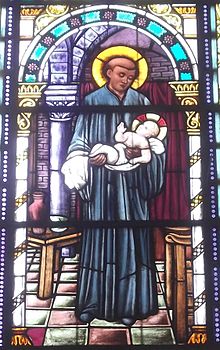Saint Benedict the Moor
| St. Benedict the Moor, O.F.M. | |
|---|---|

Stained glass of Saint Benedict the Moor, inside of the Capela do Divino Espírito Santo, Porto Alegre, Brazil.
|
|
| Religious and confessor | |
| Born | 1526 San Fratello, Messina, Sicily, Crown of Aragon |
| Died | April 4, 1589 Palermo, Sicily, Crown of Aragon |
| Venerated in |
Catholic Church (Sicily and the Franciscan Order), Lutheran Church |
| Beatified | 1734 by Pope Benedict XIV |
| Canonized | 1807 by Pope Pius VII |
| Major shrine | Church of , Palermo, Italy |
| Feast | April 4 (April 3 in the Franciscan Order) |
| Patronage | African missions; African Americans; black missions; black people; Palermo; San Fratello; Sicily |
Benedict the Moor, O.F.M., (Italian: Benedetto da San Fratello, 1526 – April 4, 1589) was an Italian Franciscan friar in Sicily who is venerated as a saint in the Catholic and Lutheran churches. Born of African slaves in San Fratello, he was freed at birth and became known for his charity. As a young man he joined a Franciscan-affiliated hermit group, of which he became the leader. In 1564 he was sent to the Franciscan friary in Palermo, where he continued good works.
Benedict was born to Cristoforo and Diana Manasseri, Africans who were taken as slaves in the early 16th century to San Fratello (also known as San Fradello or San Philadelphio), a small town near Messina, Sicily. They were given Italian names and later were converted to Christianity. The Italian "il Moro" for "the dark skinned" has been interpreted as referring to Moorish heritage. Because of his appearance, Benedict was also called Æthiops or Niger (both referring to black skin color and not the modern-day countries.)
Benedict's parents were granted freedom for their son before his birth because of their "loyal service". Like most peasants, Benedict did not attend any school and was illiterate. During his youth, he worked as a shepherd and was quick to give what he had earned to the poor. When he was 21 years old, he was publicly insulted for his color. His patient and dignified bearing at this time was noted by the leader of an independent group of hermits on nearby Monte Pellegrino, who followed the Rule for hermit life written by St. Francis of Assisi. Benedict was quickly invited to join that community, and shortly thereafter he gave up all his earthly possessions and joined them. He served as the cook for the community and at the age of twenty-eight succeeded Jerome Lanze as leader of the group.
...
Wikipedia
